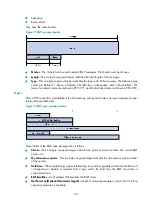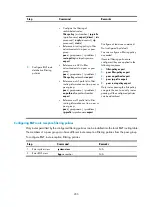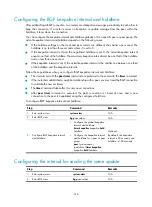
199
Task Remarks
Configuring the interval for sending the same
update
Optional.
Optional.
Enabling the BGP ORF capability
Optional.
Enabling 4-byte AS number suppression
Optional.
Setting the DSCP value for BGP packets
Optional.
Enabling quick EBGP session reestablishment
Optional.
Enabling MD5 authentication for TCP connections
Optional.
Configuring BGP load balancing
Optional.
Forbidding session establishment with a peer or
peer group
Optional.
Configuring a large scale
BGP network
Optional.
Optional.
Configuring a BGP route reflector
Optional.
Configuring a BGP confederation
Optional.
Optional.
Optional.
Enabling logging of peer state changes
Optional.
Optional.
Configuring BGP basic functions
This section does not differentiate between BGP and MP-BGP.
Configuration prerequisites
The neighboring nodes are accessible to each other at the network layer.
Creating a BGP connection
A router ID is the unique identifier of a BGP router in an AS.
•
To ensure the uniqueness of a router ID and enhance network reliability, you can specify in BGP
view the IP address of a local loopback interface as the router ID.
•
If no router ID is specified in BGP view, the global router ID is used.
•
If the global router ID is used and then it is removed, the system will select a new router ID.
•
If the router ID is specified in BGP view, using the
undo router-id
command can make the system
select a new router ID.
To create a BGP connection:
















































